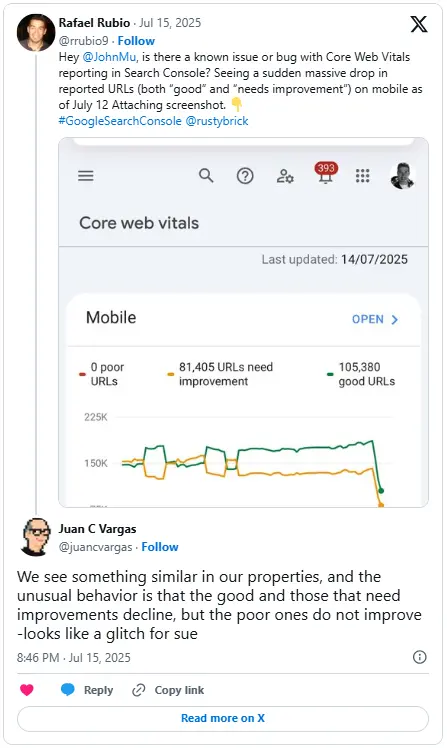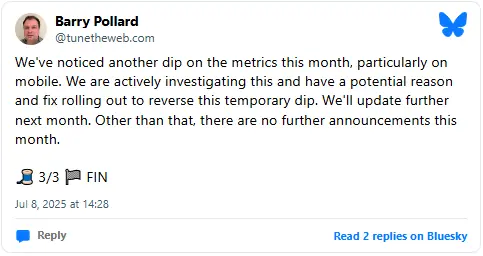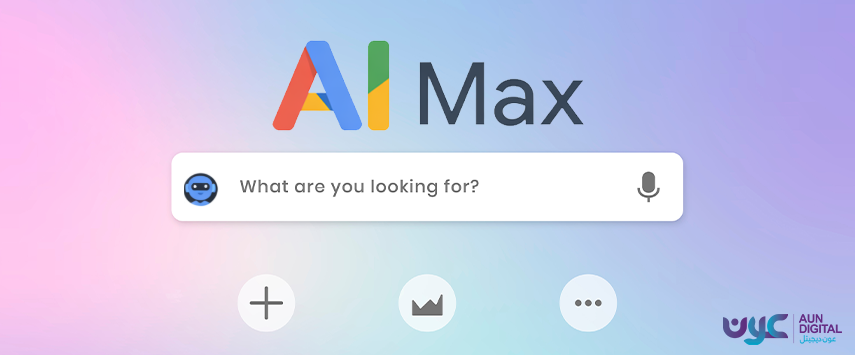A confirmed Core Web Vitals (CWV) reporting glitch in Google Search Console caused a major dip in reporting data for many sites, leading to confusion and unnecessary optimization efforts by businesses globally.
Highlights
- Google’s Search Console for CWV reporting experienced a major dip beginning July 10, 2025
- Mobile performance data dropped to zero for many websites, causing confusion across the SEO and developer community.
- The issue was traced back to a disruption in CrUX—the Chrome User Experience Report that supplies real-user performance data.
- Google clarified that no action is needed from site owners, and a fix is being developed to restore normal reporting.
- The glitch highlights the importance of cross-verifying metrics before making performance changes based on Search Console data.
The sudden CWV Reporting Glitch in Google Search Console reporting, specifically for mobile experience has left SEO experts, developers, and digital marketers questioning their site performance data. The issue, first noticed around July 10, wasn’t just a small hiccup; it showed a complete drop in mobile CWV reports across multiple websites, triggering confusion and unnecessary optimization efforts across the industry.
The issue was first highlighted by a user in Bluesky, who instantly tagged Google’s John Mueller stating that:

John Mueller instantly responded:
“The CWV reports are actually based on the samples of what Google knows about your website, and often this sample size changes. Therefore, this is not an indication of a glitch, I’d recommend to focus on samples with issues, instead of absolute counts”
Now officially confirmed, the reporting error has been traced back to Google’s Chrome User Experience (CrUX) data pipeline, the system responsible for feeding real-world user experience data into Search Console. And while the actual performance of websites hasn’t changed, the metrics used to track it disappeared without warning.
Here’s what really happened, why it caught so many off guard, and what you need to know going forward.
CWV Reports Dropped to Zero – But It Wasn’t Your Site’s Fault
Around July 10, website owners began noticing CWV reporting glitch in Google Search Console, due to a sharp drop in their Core Web Vitals metrics, especially on mobile. Some sites showed zero URLs in the “Good” or “Needs Improvement” categories. The drop created the illusion that something had gone seriously wrong with mobile performance. But as it turns out, the problem had nothing to do with website performance or coding errors.
What Actually Went Wrong?
The CWV reporting glitch in Google Search Console stems from the Chrome User Experience Report (CrUX), which supplies real-user performance data to Search Console. This data is collected from users who have opted in to anonymous performance tracking via the Chrome browser. It forms the backbone of the Core Web Vitals field data shown in Google Search Console.
Barry Pollard, a Web Performance Developer Advocate on the Chrome team, confirmed that an issue had been identified with the CrUX data feed. He acknowledged a temporary reporting dip, especially on mobile, and noted that the team was actively working on a fix.

While Pollard didn’t confirm the exact nature of the problem or when the fix would be fully rolled out, his comments helped clarify that the issue wasn’t related to website performance or Search Console itself.
Why This Matters?
The CWV reporting glitch in GSC caused more than just a display error. It led to real-world consequences, and many web teams reacted quickly to the perceived drop, launching emergency fixes and performance audits, assuming something had broken. Some began deferring JavaScript, restructuring layouts, or compressing assets, all based on data that turned out to be inaccurate.
That’s a costly misunderstanding.
It highlights how much weight site owners place on Google’s performance tools, and how a sudden change in those metrics can prompt unnecessary action. More importantly, it raises a critical question: How can developers trust performance data if it’s not always reliable?
Misleading Data Hurts More Than It Helps
Web performance metrics are used to prioritize technical work, report progress, and guide long-term SEO strategies. So, when those numbers shift unexpectedly, especially in a downward direction, it affects roadmaps, stakeholder confidence, and even budgets.
In this case, many developers wasted time and energy “fixing” issues that didn’t exist. That’s not just inefficient but also demoralizing.
This CWV reporting glitch in GSC serves as a reminder to verify anomalies before acting on them. Relying solely on one tool or dashboard creates unnecessary risk. When something looks off, it’s worth checking Lighthouse reports, real-user monitoring (RUM) tools, or even CrUX data directly before sounding the alarm.
What Should You Do Now?
Although the sudden dip in CrUX data can be worrisome, but Google’s John Mueller and Barry Pollard clarified the air, stating that although this could be a glitch but sampling fluctuations are applicable to structured data reports, https, amp, and cwp. Barry further added Core Web Vitals (CWV) are not linked with Google core updates, so there is nothing to worry as things will return back to normal.
1. Don’t panic.
If your site’s CWV metrics took a sudden dip around July 10, especially on mobile, it’s almost certainly not a reflection of actual performance issues.
2. Use multiple tools.
Cross-reference Google Search Console with Lighthouse, PageSpeed Insights, and third-party RUM platforms. If performance looks strong elsewhere, it’s probably a reporting glitch.
3. Communicate with your team or clients.
If stakeholders have seen the dip and are concerned, explain the situation clearly. Reassure them that it’s a known issue with the data pipeline and not something wrong with the site.
4. Focus on consistent best practices.
Continue improving your site’s real performance: optimise images, keep layouts stable, and reduce blocking resources. These actions matter regardless of temporary data glitches.
Key Takeaways
This confirmed CWV reporting glitch in Google Search Console shows how fragile our reliance on performance data can be. When a single data pipeline goes silent, it can set off a chain reaction across development teams worldwide. But it also shows the importance of balanced analysis, calm response, and the value of using multiple sources before making changes.
Performance still matters. But so does context.
Even though while numbers dropped, awareness rose, hopefully leading to smarter, more measured decisions the next time metrics look misleading.
Such CWV reporting glitches in Google Search Console, can raise red flags and create a state of panic amongst brands and create a state of uncertainty. Furthermore, discrepancies in data could lead towards hasty decisions and misjudgments, as a result marketing teams might neglect critical performance issues while investing time and resources on unnecessary fixes.
To avoid costly mistakes and ensuring your SEO strategy remains intact it is best to consult with a reliable and trustworthy SEO company. As they can quickly diagnose and report such as technical glitches. While focusing more towards activities targeted towards optimization of your website for peak performance.









